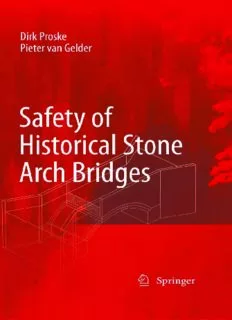
Safety of Historical Stone Arch Bridges PDF
Preview Safety of Historical Stone Arch Bridges
Safety of Historical Stone Arch Bridges “This page left intentionally blank.” · Dirk Proske Pieter van Gelder Safety of Historical Stone Arch Bridges 123 Dr.-Ing.habil. DirkProske,MSc. Dr.-Ir. PietervanGelder UniversityofNaturalResources DelftUniversityofTechnology andAppliedLifeSciences,Vienna SectionofHydraulicEngineering InstituteofMountainRiskEngineering Stevinweg1 Peter-Jordan-Street82 2628CNDelft 1190Vienna TheNetherlands Austria [email protected] [email protected] ISBN 978-3-540-77616-1 e-ISBN 978-3-540-77618-5 DOI 10.1007/978-3-540-77618-5 SpringerHeidelberg DordrechtLondonNewYork LibraryofCongressControlNumber:2009926692 (cid:2)c Springer-VerlagBerlinHeidelberg2009 Thisworkissubjecttocopyright.Allrightsarereserved,whetherthewholeorpartofthematerialis concerned,specificallytherightsoftranslation,reprinting,reuseofillustrations,recitation,broadcasting, reproductiononmicrofilmorinanyotherway,andstorageindatabanks.Duplicationofthispublication orpartsthereofispermittedonlyundertheprovisionsoftheGermanCopyrightLawofSeptember9, 1965,initscurrentversion,andpermissionforusemustalwaysbeobtainedfromSpringer.Violations areliabletoprosecutionundertheGermanCopyrightLaw. Theuseofgeneral descriptive names, registered names, trademarks, etc. inthis publication does not imply,evenintheabsenceofaspecificstatement,thatsuchnamesareexemptfromtherelevantprotective lawsandregulationsandthereforefreeforgeneraluse. Coverdesign:eStudioCalamarS.L. Printedonacid-freepaper SpringerispartofSpringerScience+BusinessMedia(www.springer.com) Preface Stone arch bridges are special technical products in many aspects. Two of the most important aspects are their very long time of usage and their land- scape changing capability. First, for more than two millenniums, stone arch bridges have been part of the human infrastructure system, and some of them are still in use. Most of the stone arch bridges now in use are older than the first century. The only type of structures reaching the same dura- tion of usage are tombs and other religious structures. However, in contrast to those, arch bridges are much more exposed to changes in usage condi- tions. There exist Roman bridges that were crossed not only by Roman legions but also by tanks in World War II. When most stone arch bridges were constructed, motorized individual car traffic was yet unknown. This load now has to be borne by these historical bridges. We should probably much more esteem the farsightedness and endeavour of our ancestors, which we often count on nowadays without perception. Or perhaps we do notice as some common attitudes indicate, don’t we? In many children’s books, landscapes often include stone arch bridges. And if people are asked whether arch bridges are disturbing or accepted, in most cases people consider arch bridges as part of our man-made land- scape and not necessarily as human artefact. Painters such as Paul Cézanne have included arch bridges in their landscape paintings as early as the 19th century, which refutes the theory that arch bridges are now just accepted because they have been part of the landscape for centuries. Stone arch bridges are considered beautiful because they apply some simple rules of aesthetics. First of all, they use building material from the vicinity and therefore are embedded in the landscape. Furthermore, the genius idea to arrange stones geometrically in such a way that the mechani- cal properties of stones are used in a nearly perfect way gives the impres- sion of harmony, whereas beam bridges made of reinforced or prestressed concrete are often felt as strange. Besides beauty, the bridges show in a very clear way one of the biggest conflicts of our human civilisation. In the untiring trial to rationally de- scribe all elements of our world, we have seen the limits of this concept in the last decades. Even though arch bridges have been built and used for more than two millenniums, we still face problems in numerically describ- ing their behaviour. Only in the last decades have appropriate tools been VI Preface provided. Such tools are presented in this book. However, the book em- beds these procedures in an even wider concept. Not only are computation strategies and strengthening techniques for arch bridges given, but adapta- tions of today’s loads to preserve the bridges are also presented. However, strengthening of arch bridges is often not required: The major cause of the destruction of arch bridges is the insufficient width of the roadway, which means not the safety but the usability has limited the life- time of the bridge. Perhaps we could live with this limitation and give re- spect to the arch bridges. They still provide us with the lowest maintenance costs of all bridge types. Expression of Thanks This book is a translation and extension of a former German book pri- marily written during a visit of the first author at the TU Delft in 2005. Therefore, first of all we thank the TU Delft for the financial support. Ad- ditional support was given to translate the book. Furthermore, many persons have contributed by proof-reading and giv- ing suggestions. Therefore, the authors thank Prof. Konrad Bergmeister, Prof. Han Vrijling, Prof. Jürgen Stritzke, and Prof. Udo Peil. Additionally, Mrs. Angela Heller did the proof-reading of the German version. We thank her for the intensive work. Last, but not least, we thank Springer and their assistants for the opportunity to publish the book in English, and for their strong support. “This page left intentionally blank.” Contents 1 Introduction...........................................................................................1 1.1 General introduction........................................................................1 1.2 Advantages and disadvantages of arch bridges.............................12 1.3 Structure of the book.....................................................................14 1.4 Terms.............................................................................................20 1.5 Classification of static bridge types...............................................29 1.6 Types of arch geometry.................................................................33 1.7 History of stone arch bridges.........................................................36 1.8 Arch bridges from alternative material..........................................47 1.8.1 Steel arch bridges.................................................................47 1.8.2 Wooden arch bridges...........................................................48 1.8.3 Concrete arch bridges...........................................................49 1.9 Number of arch bridges.................................................................50 References............................................................................................56 2 Loads....................................................................................................67 2.1 Introduction...................................................................................67 2.2 Road traffic loads...........................................................................67 2.3 Railroad traffic load.......................................................................82 2.4 Initial drive forces..........................................................................86 2.5 Breaking forces..............................................................................87 2.6 Wind loading.................................................................................88 2.7 Impact forces.................................................................................89 2.8 Settlements.....................................................................................89 2.9 Temperature loading......................................................................89 2.10 Snow loading...............................................................................92 2.11 Dead load.....................................................................................92 References............................................................................................94 3 Computation of historical arch bridges............................................99 3.1 Introduction...................................................................................99 3.2 Empirical rules.............................................................................100 3.2.1 Historical rules...................................................................100 3.2.2 Modern rules......................................................................119
Description: